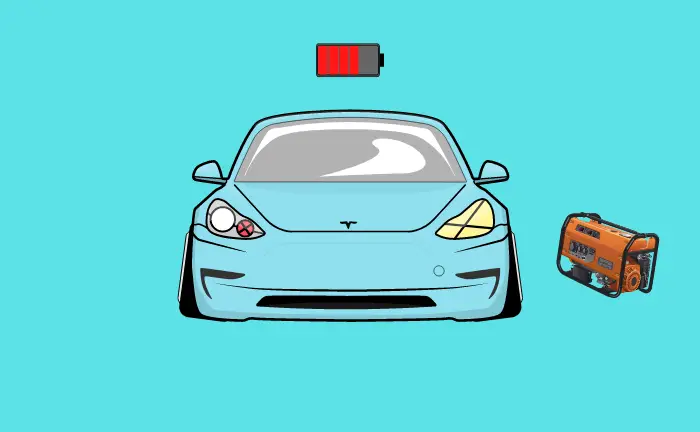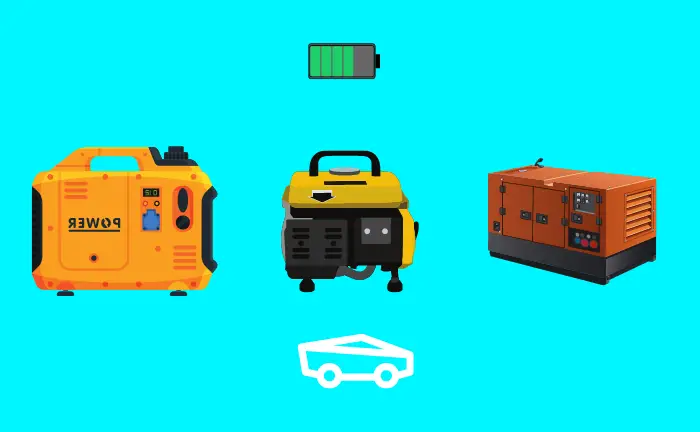What if you own a Tesla and face a severe power outage for days? How will you recharge your car then? These are the questions many Tesla owners have when facing a power outage. Similarly, you can get in trouble if your battery runs out while traveling and there is no nearby help to call. This is nothing less than a nightmare to get stuck with a dead battery.
There are many reasons to think of charging a Tesla with a generator. But the question is, can you do that? Since many Tesla owners ask this question, we decided to give you a detailed answer in this article. You’ll discover everything you need to know about generators and Tesla. So without any further delay, let’s get straight into it.
Table of Contents
Can A Generator Charge Tesla?

Tesla requires electricity to charge its battery, and the generator is a backup power source when needed. So yes, you can charge Tesla with a generator. However, things are not as simple as it looks. To get the proper answer, we need to understand the charging system Tesla first and see how a generator is compatible with it.
Tesla contains a battery with thousands of lithium-ion cells that take current to charge. It includes an onboard converter to determine whether it’s a DC or AC. If the current supply is DC, it regulates the power directly to the battery; contrary to this, if the current is AC, it will regulate the current to the onboard converter and convert it to DC.
However, power outlets installed in homes produce AC; therefore, Tesla, when plugged in, will convert the current via a board converter first and move further.
What Is The Standard Power To Charge A Tesla?
Usually, a Tesla requires a current of 240 V for optimal charging but could also work on 110/120 V. Power outlets installed in homes produce a current of 120 V at 30 A, which is acceptable. However, less power supply means it will take considerably longer to charge than a 240 V outlet. A low-speed supply could also risk the heat factor in the battery that could create damage. However, Tesla contains a charging monitor that automatically turns off the supply when the battery is fully charged.
A generator burns fossil fuel and produces electricity. This electricity is created at 120 V at 30 A, which adds 4 miles of range per hour to Tesla. The supply ratio is low and would take a night to add up to 30 miles. Contrary to this, a supply of 240 V will add 30 miles per hour and fast charge the battery accordingly.
Can You Plug The Tesla Directly Into Generator?
Having the facility to charge Tesla with a generator does not mean plugging the cord directly. Tesla comes with a proprietary plug that works as a network between the power outlet and the car. The benefit of this proprietary plug is that it monitors the current supply and handles high voltages easily.
What Type Of Generators Work For Tesla?

There are several options available in generators for charging a Tesla. Multiple models are available in the market, and they aren’t the same. Each model varies in size, feature, fuel, power, and price.
Therefore, we’ve composed some generators that can charge the Tesla. Check them out as follows.
Natural Gas Generators
Here we have the first and the most common type of generators. Natural gas generators are affordable and produce a power of 120 V at 20 A. Natural gas generators are common in rural residences. These generators serve as a backup and, in many cases, start automatically.
The bulk of natural gas power generators are fixed, so they cannot be moved. These generators are built to power a full house for lengthy periods. They are also frequently placed in conjunction with solar panels. You can easily charge your Tesla with a natural gas generator. The greatest flex you have is that your home contains gas pipelines which allow you to store the gas properly.
Gasoline Generators
Here we have another most common type of generator―Gasoline generators. When you think of a generator, you generally think of one that runs on gasoline. These are the most typical and may be found in hardware stores and outdoor retailers. Gas-powered generators are unique from those that run on compressed natural gas or propane.
Gasoline generators are inexpensive, starting at $250-$300. Most of these low-cost units have small fuel tanks and don’t create much power, but they can produce 110 V at 15 A or more. However, it comes with one downside―it consumes fuel quickly. So it might cost you extra gallons if you want to charge Tesla on it. Furthermore, it produces toxic fumes every time, making it not an eco-friendly option either.
Diesel Generators
If you are looking for something big and efficient, then a diesel generator is your optimal choice. Diesel generators are significantly more efficient than gasoline generators. On the other hand, a tiny portable diesel generator is unlikely to be found, which is a little unfortunate for a common man.
Diesel is only used in larger units like emergency backup and industrial units and takes considerably more space than most other generators. Talking about the power, the vast majority of diesel generators have enough power to charge a Tesla. It produces a power of 240 V at 30 A, adding up to 30 miles per hour to your Tesla.
Portable Generators
Portable generators, as the name suggests, are easy to carry anywhere along with you. Portable generators are available at any hardware shop. They typically have between one and six power outlets and do not have a starter. These generators are dependable, but less expensive units aren’t meant to operate for days on end.
But since the discussion is about charging the Tesla with the most convenient source, a portable generator is ideal.
Which Generator Is Suitable For Tesla?
Considering all the technical aspects and situations, Tesla needs efficient and convenient assistance found in portable generators. Portable generators are compact and can be taken anywhere hassle-free. Unlike giant heavy generators, portable generators cover small spaces and can also be stored in a car.
Suppose you’re at a picnic and your car breaks down; which generator would be the most suitable for you? Obviously, portable generators because it allows you instant access anywhere, anytime. All you have to do is to take out the generator and run and plug the Tesla extension in its outlet. Moreover, portable generators produce energy of 110/120 V at 15 to 30 A, which adds 4 miles to Tesla in an hour.
So if you cannot decide between generators for your car, take our suggestion and go for portable ones.
Is It Considered Slow Charging Or Fast Charging With Generators?
You have to evaluate your generator model and capabilities before determining whether it does slow charging or fast charging. Most of the generators produce electricity at the power of 110 V at 30 A, which takes overnight to add 30 miles to Tesla. Therefore, it is normally considered slow charging. However, the optimum charging power is 240 V which adds 30 miles in an hour, called fast charging.
Diesel generators are known for providing such speed, but they are limited to industrial use only. Moreover, these generators run by burning fossil fuel which evaporates toxic fumes in the environment, making it not an eco-friendly choice.
What Are Tesla Charge Controllers?
Tesla has built-in charge controllers, but many charging stations also have charge controllers. Because the flow of power from these devices is substantially higher than a typical 120-volt wall outlet, the quickest Tesla charging systems use computers to manage current and voltage.
To charge a Tesla, you don’t need an external charge controller. However, the lack of a charge controller restricts you to lower voltage and less current, so utilizing an unregulated cable will take substantially longer than using a more complex system like the Tesla Wall Charger.
Wrapping Up
The invention of electric cars has reduced the dependency on fossil fuels, which is both budget-friendly and eco-friendly. Where electric cars have provided comfort to the users, on the one hand, it has also made them think of alternative ways when the power goes out. Tesla is known to be the most popular car that runs on electricity and can be charged via home power outlets.
But is it possible to generate a Tesla with an external source (a generator? There comes the idea of charging Tesla with a generator. Although Tesla requires a minimum of 110 V to charge its battery, generators are suitable for them. However, the charging process must be carried out carefully, considering all the essentials. Keep in mind the above-given information and use a reliable portable generator only to charge your Tesla.
So your question is duly answered here. I Hope this article will prove helpful to you.

